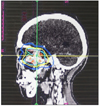Abstract
Purpose
To report a case of a female patient treated with stereotactic radiosurgery for compressive optic neuropathy by recurred maxillary cancer.
Case summary
A 51-year-old woman with a history of maxillary cancer presented with decreased visual acuity and visual field and color vision defects in the right eye. The CT scan revealed a wide spread mass along the ethmoid sinus, orbit, optic canal, and skull base. Under the impression of compressive optic neuropathy, stereotactic radiosurgery was performed. A cumulative dose of 39 Gy in 3 daily fractions of 13 Gy was administered to the mass. After 10 days, visual acuity, color vision, and visual field improved and were maintained after a 2 month follow-up.
Figures and Tables
Figure 1
Axial CT scan demonstrating extensive mass involving both orbits, ethmoid sinus, and skull base.

References
1. Adler JR Jr, Chang SD, Murphy MJ, et al. The Cyberknife: a frameless robotic system for radiosurgery. Stereotact Funct Neurosurg. 1997. 69(1-4 Pt 2):124–128.
2. Adler JR Jr, Gibbs IC, Puataweepong P, Chang SD. Visual field preservation after multisession cyberknife radiosurgery for perioptic lesions. Neurosurgery. 2006. 59:244–254.
3. Pham CJ, Chang SD, Gibbs IC, et al. Preliminary visual field preservation after staged CyberKnife radiosurgery for perioptic lesions. Neurosurgery. 2004. 54:799–810.
4. Zada G, Yu C, Pagnini PG, et al. Early decreased tumor volume following fractionated Gamma Knife Radiosurgery for metastatic melanoma and the role of "adaptive radiosurgery": case report. Neurosurgery. 2010. 67:E512–E513.
5. Tishler RB, Loeffler JS, Lunsford LD, et al. Tolerance of cranial nerves of the cavernous sinus to radiosurgery. Int J Radiat Oncol Biol Phys. 1993. 27:215–221.
6. Leber KA, Berglöff J, Pendl G. Dose-response tolerance of the visual pathways and cranial nerves of the cavernous sinus to stereotactic radiosurgery. J Neurosurg. 1998. 88:43–50.
7. Morita A, Coffey RJ, Foote RL, et al. Risk of injury to cranial nerves after gamma knife radiosurgery for skull base meningiomas: experience in 88 patients. J Neurosurg. 1999. 90:42–49.
8. Stafford SL, Pollock BE, Leavitt JA, et al. A study on the radiation tolerance of the optic nerves and chiasm after stereotactic radiosurgery. Int J Radiat Oncol Biol Phys. 2003. 55:1177–1181.
9. Hasegawa T, Kobayashi T, Kida Y. Tolerance of the optic apparatus in single-fraction irradiation using stereotactic radiosurgery: evaluation in 100 patients with craniopharyngioma. Neurosurgery. 2010. 66:688–694.
10. Roh KW, Jang JS, Kim MS, et al. Fractionated stereotactic radiotherapy as reirradiation for locally recurrent head and neck cancer. Int J Radiat Oncol Biol Phys. 2009. 74:1348–1355.




 PDF
PDF ePub
ePub Citation
Citation Print
Print




 XML Download
XML Download